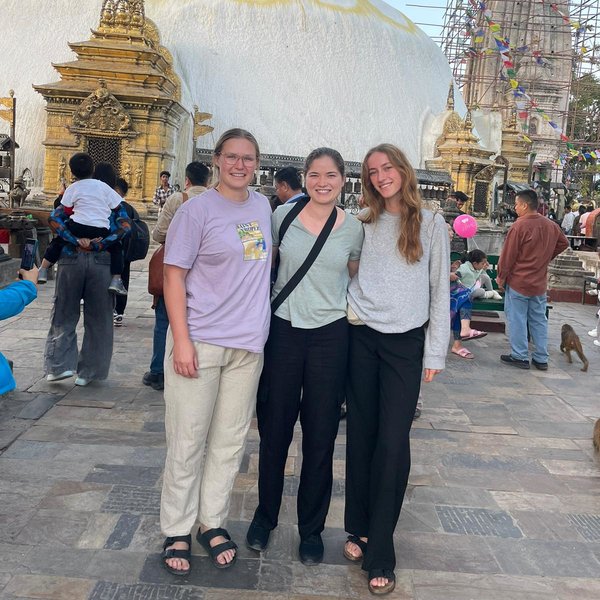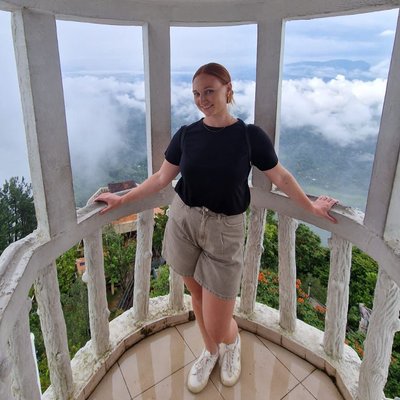Deakin University 2019
 The Philippines has always been on my list of places to visit as my father visited the province of Iloilo 20 years ago to build a nutrition centre. I always remember him telling me of the beautiful country and of the wonderful people who lived there. So, when a fellow classmate asked me if I wanted to join her on a Work the World placement to The Philippines, I jumped at the chance.
The Philippines has always been on my list of places to visit as my father visited the province of Iloilo 20 years ago to build a nutrition centre. I always remember him telling me of the beautiful country and of the wonderful people who lived there. So, when a fellow classmate asked me if I wanted to join her on a Work the World placement to The Philippines, I jumped at the chance.
I rang Work the World that night and the team were super helpful in pointing me in the right direction. They advised that there was only one more midwifery position available for the dates I wanted, so I took that as a sign and booked. During this process the Work the World team answered all of my questions and were very involved leading up to my departure. The team uploaded all my details to MyTrip - Work the World’s online placement planner. MyTrip allowed me to see who else would be in the house with me and gave me an insight into what to expect when I arrived.
The Work the World team tailored my placement to my clinical interests, ensuring that I spent time in areas that were of interest to me. They did this via MyTrip where you can enter your clinical areas of interest and placement goals to help the team tailor your placement to suit you.
The focus for my clinical placement was midwifery, so the team placed me in the maternity units. This included the postnatal ward, delivery room, antenatal care, young parents’ clinic, NICU, obstetric OR and obstetric ER.
 When we landed in Iloilo, a member of the Work the World team met us and picked us up from the airport to take us back to the Work the World house. The other students and the rest of the Work the World team were there to greet us when we arrived. Although this was a bit overwhelming at the start, everyone was so friendly, and soon enough I had friends from all over the world.
When we landed in Iloilo, a member of the Work the World team met us and picked us up from the airport to take us back to the Work the World house. The other students and the rest of the Work the World team were there to greet us when we arrived. Although this was a bit overwhelming at the start, everyone was so friendly, and soon enough I had friends from all over the world.
On the first day of placement, the team introduced us to the hospital, gave us a tour of the departments and introduced us to the whole hospital team during the flag raising ceremony. We then went on a tour of the city and a traditional lunch. During this time the Work the World team helped us set up local sim cards for our phones and answered any questions we had. This day was also a great way to get to know the other students on placement and start organising weekend trips.
During our time in The Philippines, we enjoyed diving into the local way of life by riding the local transport (Jeepneys) to and from the hospital every day. This was quite an experience, but we eventually got used to it. The team also taught us phrases that helped us pay for our trip each day and say thank you to the driver.
The hospital in Iloilo was a public hospital so entering for the first time was a little overwhelming. There were people everywhere, and the hustle and bustle continued all day. One thing I noticed at the hospital was the number of patients seen by one person in a day. For example, one midwife would see anywhere between 20-40 young women in the young parents’ clinic. Comparing this to my experience as a student in Australia, one midwife in a clinic back home would typically only see up to 10 patients in a shift. This meant that the appointments in The Philippines were often shorter than we would have in Australia, and often multiple patients were in the same room at once.
 Another key difference was the amount of resources available to patients and the staff in The Philippines. For example, many patients in labour did not have access to pain relief due to the cost and they would labour alone without support from a partner or family member. This may have been due to culture, but there was also a lack of space to have support people in the birth suite.
Another key difference was the amount of resources available to patients and the staff in The Philippines. For example, many patients in labour did not have access to pain relief due to the cost and they would labour alone without support from a partner or family member. This may have been due to culture, but there was also a lack of space to have support people in the birth suite.
After birth, a midwife took the baby and cared for it until the doctor could review them before returning them to their mother and taking them both to the postnatal ward. I was surprised when I first saw the postnatal ward. I realised how good patients really had it in Australia. The postnatal ward was one room that contained 45 beds, and often due to the large amount of births these beds were shared by more than one woman.
It was interesting to watch the care on the postnatal ward because it was so crowded.
Despite all of this everyone seemed so content and happy to be sharing. It was interesting to watch the care on the postnatal ward because it was so crowded. However, the doctors still managed to get around and see every woman and baby.
 I was fortunate enough to spend time with one of the paediatric doctors whilst in the delivery room and NICU. He acknowledged the lack of resources and explained to me how the hospital couldn’t turn patients away because they were a public hospital servicing such a large area. Hence they were often over capacity. He explained that they must rely on the most basic methods when identifying problems, using sight, touch and sound. Before there were machines, there were just people and often when the machines were not available in The Philippines, it was using basic equipment that kept people alive. For example, the cost of having ventilators was rather expensive and often a simple bag and mask system had to be used, and this was done by patients’ family members. They sat at the bedside of their relative and manually ventilated them. I was in awe of the dedication of the family members in these times, and it really made me appreciate the systems we have in place back home.
I was fortunate enough to spend time with one of the paediatric doctors whilst in the delivery room and NICU. He acknowledged the lack of resources and explained to me how the hospital couldn’t turn patients away because they were a public hospital servicing such a large area. Hence they were often over capacity. He explained that they must rely on the most basic methods when identifying problems, using sight, touch and sound. Before there were machines, there were just people and often when the machines were not available in The Philippines, it was using basic equipment that kept people alive. For example, the cost of having ventilators was rather expensive and often a simple bag and mask system had to be used, and this was done by patients’ family members. They sat at the bedside of their relative and manually ventilated them. I was in awe of the dedication of the family members in these times, and it really made me appreciate the systems we have in place back home.
Leaving the hospital at the end of the week gave way to a weekend away for rest and recovery before jumping back in on Monday the following week. The weekend I had off I spent in Boracay with 20 other students. We loaded onto a bus in the early hours of the morning. We made it to the island before lunchtime to enjoy the sun, the heat and the stunning white beaches.
 Each weekend, we aimed to get away to explore the beautiful country and experience the beautiful culture. We formed close bonds with the other students and became like one big family whilst we were away. We not only enjoyed the weekends away together, but also the time before and after our shifts. We would explore the local area together, eat the local food, and head to the swimming pool near the Work the World house to help us cool down. The Work the World team threw a BBQ every Thursday, followed by karaoke. Everyone had to sing, including the Work the World team. This made for a fun evening and a night full of laughter.
Each weekend, we aimed to get away to explore the beautiful country and experience the beautiful culture. We formed close bonds with the other students and became like one big family whilst we were away. We not only enjoyed the weekends away together, but also the time before and after our shifts. We would explore the local area together, eat the local food, and head to the swimming pool near the Work the World house to help us cool down. The Work the World team threw a BBQ every Thursday, followed by karaoke. Everyone had to sing, including the Work the World team. This made for a fun evening and a night full of laughter.
It really made me come home with a new sense of appreciation
The one thing from my trip that will stick in my mind forever is all the people that I met. It was amazing to see how people who seemed to be suffering hardship, were still able to smile through the day and stay appreciative. It really made me come home with a new sense of appreciation for everything that the Australian healthcare system can offer.
If you’re considering going to The Philippines, I have three things to say:
1. Go for it. Jump at the chance to experience another culture and healthcare system. Dive in headfirst and immerse yourself in the experience, you may not get another chance, so do it while you can.
2. Be open minded. The practices within the healthcare system can be very different from back home, so keep an open mind and do not judge. You are there to watch, learn and experience.
3. Enjoy. Enjoy your time, enjoy the culture, and enjoy the experience of a new country.









